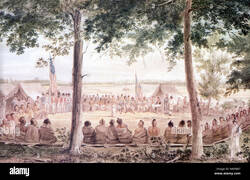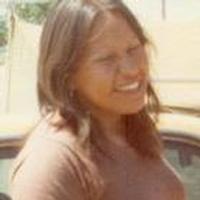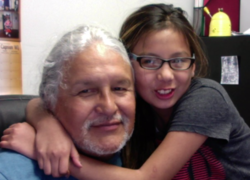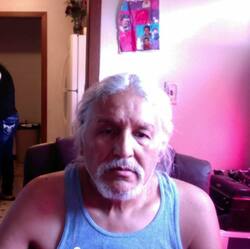THE EARLY YEARS
I was born in Devils Lake, North Dakota, in 1953. During my infant and toddler years, I lived in the East End. The East End was the eastern part of the reservation where my dad grew up. But most of my memories are in Crow Hill, where my mom was born and raised. My mom and my dad separated when I was a toddler. In Crow Hill, we lived in a two-room frame house; part of it was a frame house; part of it was a log cabin with a porch attached to it. I remember it being warm and cozy. We had a kerosene stove with three burners, which we cooked on. I remember the older kids going to school and wondering where they went.
We explored all the trees and hills within a five-mile radius and played many games to keep us occupied in the evening. We ran around the woods, went down to the lake, and swam. I remember my auntie, on my dad's side, stayed with us. We called her Auntie Abu. A Dakota word, "Abu," is inserted in a lullaby Dakota mothers used to sing to their babies. "Abu, Abu ...go to sleep... "She used to sleep on the floor behind the kerosene stove because it was warm, and her thakoza [grandchild] would sleep with her. Back then, the adults would talk in Dakota all the time. It was a good life. I didn't have a care in the world.
We always had lots of dogs and cats. Back then, dogs were not allowed in homes, no matter how cold it became. My stepdad had built a shelter for them using the angle iron from an old iron bed. I happened to trip and fall right on the edge of the angle iron, and its sharp edge cut a deep gash right next to my nose. The rip became a huge scar that is still noticeable today. Back then, we did not run to the clinic when we were sick or hurt; we just toughed it out.
One summer day, my cousin Timmy, my sister Becky, and I- I must have been about four years at the time- went to the lake to swim. When we arrived at the lake, we saw smoke coming from the direction of our house. Becky said, "I want to see where the fire is coming from." She looked worried when she left. Timmy and I followed her, but we took our time. Becky came running back, and she was crying. She sobbed, "The house is burning down." We ran up the hill, and sure enough, the house was on fire, and there were people around it watching it burn. I remember my older sister Tina at one of the windows trying to save her cats, but an older relative quickly grabbed her and pulled her to safety. About half a dozen cats perished in the fire. We lost everything in the house. No one died, but we lost everything.
That was the first significant change in my life. I went from living in a comfortable house to a tent for the rest of the summer. I remember the generosity of people; someone donated a canvas tent we put up in the woods. Other people brought food, blankets, cooking utensils, and other stuff to replace what we lost in the fire. We stockpiled everything in the tent, cooked the food over an open fire, and we kids used the lake to wash up daily. There were about six or seven of us kids. I say six or seven kids because my oldest brother was seldom home. I think he mostly stayed with friends or relatives in Fort Totten. We all couldn't fit in the tent, so most of us slept outside around the tent. When it rained, we all tried to squeeze into the tent not to get rained on. It was miserable. Due to this experience, I don't view camping as an enjoyable experience. Instead, I consider camping outdoors as an unpleasant activity that I try to avoid.
Several relatives constructed another log cabin about one hundred yards from where the old log cabin stood. It was a one-room log cabin much smaller than the old one. Wooden planks extended a third of the way across the ceiling to create a loft. We used a ladder nailed to the wall to climb up to the loft at bedtime. Before, we would go to sleep, and when we woke up in the morning, we would peer over the planks to see what was happening downstairs. It was the warmest place to sleep in the wintertime and the hottest place in the summer. Two older sisters and a younger sister (the baby), three younger brothers, an older brother, and I slept in the loft. My older brother spent several months at a sanatorium for TB, and when he came home, he spent most of his time with relatives in Fort Totten. With him absent most of the time, one of my sisters slept on his bed. Eventually, mom put a full-size bed downstairs, and the girls all moved downstairs. And that's what I remember of my first five years.
My mom, who read a lot, was a knowledgeable person. I think Mom went up to ninth grade. Although English was her second language, she spoke it fluently, but she spoke Dakota most of the time. I know a couple of words [in Dakota], well, I know more than a couple of words, and I can follow a conversation in Dakota if English words are inserted now and then and spoken slowly. Mom raised ten children and did an excellent job. However, two of my older siblings who became alcoholics died of liver failure, a third older sibling died of a drug overdose, and my younger brother committed suicide due to alcoholism. Another older sibling died of cancer. In total, I had four older siblings and five younger siblings. In my opinion, the extreme poverty we grew up in and the alcoholism that was so prevalent on the reservation damaged their character and made them susceptible to addiction.
We were impoverished: we lived in a small one-room log cabin sweltering hot in the summer and freezing in the winter with no electricity and running water. We never had toys, bikes, sleds, or candy for anything other than food and clothes, and sometimes we had no money for those necessities. We very seldom left home. At one time, we raised rabbits and chickens, and we ate a lot of eggs. Now and then, we would skin a rabbit or kill a chicken. It was hard to kill a pet. A couple of winters, my stepdad snared wild rabbits, which mom made [into] stew.
Always short on food, Mom would jump at the chance to send us to church because the ministers would say, "Send them to church, and we'll feed them sandwiches later." They would also provide transportation. For the most part, learning about Christianity wasn't bad, but I hated white people back then; for whatever reason, I didn't like them, and the ministers were white. I finally figured out by the time I was eleven or twelve years old that the values Christianity promoted and how the Christians I knew behaved were different. I realized there were no true Christians, just people who claimed to be Christians. Christians acted the opposite of what my mom taught me: never lie, stand up for what is right, help others, and share what you have with people who don't have anything. By the time I was eleven or twelve years old, I had rejected Christianity altogether. I did love listening to Christian hymns, though, and I continue to listen to them. It was a habit I kept hidden from everyone for years.
My older brother left home when I was eight or nine. The subsequent three oldest siblings were all girls. Since we neither had electricity nor running water, we had many chores. When I would get off the bus, my stepdad would have my younger brothers, and I helped him saw the wood, split it, and carry it into the house. Once we ensured we had enough wood for the night and the next day. Often, Mom would put the water pails in her trunk and go someplace, come here to Fort Totten or some other place, and fill up the water pails and bring [them] home. Using the car to haul the water was much easier than carrying water half a mile or so. Eventually, someone came out and tried to dig us a well, but they couldn't find any water. They finally struck the water, but it was so deep it took two of us to pump it out. They dug us a water line from the pump to our log cabin and connected it to a tank in our house. I don't recall the tank getting full; it was so hard to pump the water. In the wintertime, we melted snow, which was our water, or we caught rainwater in the summer, the water we used to wash clothes. In the summertime, we always swam, so we never had to worry about staying clean. In the wintertime, now and then, Mom would get out her enormous tub and fill it up with snow, put it on the stove, and when it was full of warm water, one of us would get in there and take a bath. I remember we always had a lot of impetigo sores back then, and I think the reason was that there was not enough water to take baths. I've still got scars on my legs from them.
We hauled or pumped water and sawed and split wood until we moved to Fort Totten when I was fifteen. For the most part, I remember my childhood as a happy time. It was tough; we wished for toys, we would have like better food, new clothes, and stuff like that, but it was still a good life. Probably the happiest time was when Mom was [cooking on] Sundays. Mom would always manage to get a chicken for Sunday dinner. We would go to church, and she would have a chicken dinner when we came home. The whole family would sit at the table and eat. Those Sunday dinners were probably the happiest times in my young life. But then again, it was a different time; our family was close, and we all loved and respected each other. We had cousins who lived over the hill from us. Together, we ran around Crow Hill all day, went swimming in summer, and slid on cardboard in winter. There were tough times, too, when there wasn't enough to eat; the log cabin was hot in the summer and cold in the winter, but mostly, I remember my life during that time as happy. Man! There are times when I miss those days.
BIA School
My experiences with the white man's education began at the old Fort in 1959. I was in the kindergarten class, and I remember it was a terrifying experience. We lived out in the country and didn't see many people. We were loners out there. Everything was so strange. Suddenly, I was left alone with this crowd of peculiar children, the teacher was a black woman, and she was mean. I couldn't figure out why she was black because I had never seen a black person before. They closed that old school in the second year and moved us into a new school they had built the year earlier. Miss Daggs was also the first-grade teacher, so I had to endure another year with her. By the end of the second year, I figured out Miss Daggs, as mean as she was, favored me, even though she would still beat me with a ruler now and then. Here's why I thought that: one day, when I was at home sick on my birthday, around about, the school bus came over the hill and pulled up beside the log cabin. I'm wondering what the heck is going on.
My entire class got off the bus, along with Miss Daggs, carrying a birthday cake. They all stood by the window and sang happy birthday to me. Mom went outside, and Miss Daggs handed her my birthday cake. She [Miss Daggs] kept me for another year; altogether, I spent three years in her classroom, and then she promoted me straight to third grade, having me skip second grade. They put me with a teacher called Mrs. Reynolds, who was meaner than Miss Daggs. She slapped me hard once because I wasn't paying attention. She would pull our ears, grab us by the shirt, jerk us around, shake us, and yell at us.
My sister started reading to us when I was in about the third or fourth grade up in the loft of that log cabin. She would read aloud books like The Wizard of Oz and The Boxcar Children, and Alice in Wonderland to us. She was about four years older than me, and since there was no TV or anything, we looked forward to her reading books. That's how she kept us in line, too: "If you don't behave"-she used to babysit us-"if you don't behave, I'm not going to read to you guys tonight." It's how we all became readers. Once I started reading, I wouldn't stop. Mom would tell me, "istima," when I would sit at the table using an old kerosene lamp as lighting and read long past my bedtime. Istima means "go to sleep" in Dakota. My younger brother read just as much as I did, if not more. As time went by, our lives became a little bit better, and Mom was able to give us money at times. My brother and I would go to town with Mom, buy a couple of books, and then trade back and forth until we had both read the other's books. If somebody had a book, I would ask them for it whenever I went. I didn't care what subject it was; I read it. The worst thing about grade school was they had a library, but they never let students read the books in it, much less check them out. I went into that library to get a film projector. I remember seeing rows and rows of books; I just wanted to read them badly. When we would line up for dinner, it would be right across from the library. Man! I would stand there wondering what kind of books were in that library. I was dying to get my hands on those books, but they never once opened them up to us students.
I don't recall it ever bothered us because that's how life was back then. We were always fighting with this person or that person. Therefore, physical violence was a way of life for us. Although the teachers were mean, they couldn't hurt or scare us. They were not as bad as going out to the schoolyard, getting into a fight with somebody older, and getting the crap beat out of you. They became scared of us as we got older. So, they were careful about how they treated us in the upper grades. I remember one teacher would run to the door all the time every time we started arguing with each other. He was the seventh-grade teacher, and anytime something happened in class, he would run to the door and call the principal; he was so scared of us. I remember an eighth-grade teacher, Miss Stenjen, who was one of the kinder teachers. One time she brought me several shirts. I remember she would bring me clothes because my clothes were ragged. Mom never had enough money to buy us new clothes. By the time I reached eighth grade, life was great. I had complete freedom because, by that time, mom had married a white man, but he never raised us and let me do whatever I wanted to. I was free to come and go and do whatever I wanted, and life was great.
Log Cabin
Back then, most ndn lived in log cabins, shacks, or older frame homes deemed unlivable today. After our house burnt down, friends and relatives built another log cabin for us.
Their log cabin was small; it was about 40' x 40' square. A closet was against the northwest corner of the west wall. Next to it, on the west wall, was his mom's sewing machine. Next to that was mom's dresser, and next to her dresser, in the southwest corner, was mom's bed. Next to mom's bed, along the south wall, on a shelf, was one of those old radios that needed a massive battery and a wire connected to an antenna on the roof to pull in radio signals. Next to the radio was a stand with a washbasin. Next to the stand with a washbasin was a cream can we used to hold water. A door was next to the cream can. Across from the door was a woodbin in the southeast corner. Next was a kerosene-cooking stove on the east wall, followed by an open space. Our stepdad nailed a ladder to the wall in this space. We used it to climb up to the loft. My brothers and I slept in the loft on mattresses on the floor. On the other side of the open space was a cupboard. On the north side was another dresser against another bed that the girls slept on at night. A wood stove and table were in the middle of the room. And that was the extent of the furniture in our one-room log cabin. Due to the loft becoming extremely warm in the summer, the boys slept outside in a tent or an old junked-out station wagon.
Later the wood stove that kept them warm in the winter was replaced by a fuel-oil stove with a defective regulator. We constantly monitored the bad regulator so it wouldn't flood and start the house on fire. A propane gas stove eventually replaced the wood stove. Mom used a kerosene-cooking stove for cooking, which she replaced with a woodburning cookstove. With a woodburning oven, she constantly turned everything she baked so it would cook evenly on all sides. With the gas stove, mom could bake bread without turning the dough around. With the purchase of a fuel oil stove used to heat the house and the gas stove used for cooking, we boys didn't have to saw, split, and haul wood into the house anymore.
During the winter, they spent hours playing on the lake below the house once it froze. With makeshift sleds (car hoods and other pieces of metal, wood, or whatever they could get their hands on, they were able to fashion in sleds), they slid down every hill within a couple of mile radius. And, of course, they built the usual snow forts, tunnels, and other stuff. They swam in the lake in the summer and hiked all over Crow Hill. They knew every inch of those hills. They knew where to locate all the berry bushes and where all the rabbit trails were. They even found a long-lost cemetery long overrun by bushes and trees. As a result of all this physical activity, they were lean, sunburnt, had boundless energy, and were as healthy as a horse. They very seldom became ill.
THE BLIZZARD OF 1966
I was 13 years old when the Blizzard of 1966 unleashed its fury on the Northern Plains. It was the worst blizzard in decades, certainly the worst in my young memory. It brought all human (and animal) activity to a standstill. I was 13 years old when the Blizzard of 1966 unleashed its fury on the Northern Plains. Well, not all activities. We lived in a one-room log cabin with a wood stove to heat the house. As the oldest son at home, I was responsible for seeing enough wood sawed every evening. I had to saw the wood, split it, haul it inside and stack it in the wood box every evening before I could go outside and play with my siblings and cousins who lived over the hill from us. I usually hauled in and stacked enough sawed logs in the house until the following afternoon, when I would get off the bus and do it all over again.
My younger brother, Mark's job was to pump water at our water pump located about 30 yards from the house. A water pipe ran underground from the water pump to a tank in the log cabin. I don't recall him ever filling that tank because the water was tough to pump. Now and then, the water pipe froze, and we would have to haul water from Fort Totten in the trunk of Mom's old '50 Chevy. We supplemented that drinking water with melted snow water to wash dishes, wash our hands and face, and other stuff that needed cleaning.
The eve before the Big Blizzard struck, I was home alone with my younger siblings. Mom, her sister Loretta and Loretta's boyfriend, Mike, went to watch my older cousin, (Big) Dave Longie, play in the district basketball tournament. Big Dave was the star basketball player for the Oberon Bulldogs' high school basketball team. My aunt Loretta (and Mike), who lived just over the hill from us, often went places with Mom during the winter due to the trouble of keeping cars running. Back then, automobiles were old and unreliable. Winters were harsh, and temperatures remained well below zero for days. Therefore, owning a car running during the coldest months of the winter was not easy. I also recalled the wind blew harder, and it snowed a lot more.
As the babysitter, I could sleep in Mom's bed until she returned. Sleeping in Mom's bed was a real treat because it was soft and had warm blankets. Most kids slept in the loft on mattresses on the hard floor with heavy quilts to keep us warm. One benefit of sleeping in the loft was it was the warmest place to be in the winter. We often had to fight over the quilt during the winter when the fire in the stove went out during the night. However, it quickly warmed up when the fire started again in the morning. Before falling asleep in Mom's bed, I remember hearing the wind blowing hard and the house becoming cold. I also wondered why Mom wasn't home.
I woke up sometime during the night because the fire in the wood stove had gone out, the house was freezing, and Mom still wasn't home. By then, I could hear the storm raging outside and realized there probably wouldn't be any school that was okay with me, so I went back to sleep. The school wasn't my favorite place anyway, I usually missed around 20 days per year, so I looked forward to another day of staying home. My younger brother Cory was making a fire the next time I woke up. Cory was an early riser and often would get up to help Mom start the fire, or he would begin to do it under her supervision.
Once the house warmed up, one of us made breakfast out of rolled oats or cornmeal, commodities we received every month. I wasn't worried or surprised that Mom wasn't home. People often were stranded in bad weather and stayed at the homes of relatives or friends.' And, sometimes, Mom would work at the valley picking potatoes and would be gone for several days, so it wasn't the first time we kids were home alone for more than a day. We knew how to take care of ourselves.
Anyway, the strong wind blew through the cracks in the log cabin, which meant we had to burn more wood than usual to keep warm. We soon ran out of wood and had to venture outside for more. However, the wind was so strong, there was too much-blowing snow, and the temperature was too cold that there was no way we could saw wood outside. I decided to move the sawhorse into the porch out of the wind and cold. I think it was my younger brother Cory who suggested, why don't we move the sawhorse inside the house? There were no adults around to tell us, "No, you can't do that," so that is what we did. With sawhorse inside the house where it was warm, I had no trouble getting my younger brothers Mark and Cory to help me saw wood. We had plenty of sawed logs to keep us warm. My two younger brothers, Marshall (Pete) and Chris, were too young to help. My other younger sibling, April, was also too young to saw wood. Plus, she was a girl, and girls weren't allowed to saw wood back then, at least not while I was able to.
My oldest brother, Phillip John, had hitchhiked to California a couple of years earlier; Martina and Marcy were in a boarding school at Maddock, ND. They came home on weekends. My other older sister Becky usually stayed in Fort Totten with her friends or at my aunt Alvina's home. That left me as the oldest child at home and the chief babysitter. Our stepdad had also hitched to California with his nephews the previous summer. (Three of my older siblings, Phillip, Martina, and Marcy, as well as a younger brother, Mark, have since taken the journey over the star road home and now reside in the Spirit World.)
Here is where my memory is blurred. I remember we were home alone the entire first day of the storm. I do not remember if it was during the first day or the second of the storm that I decided to see how our cousins, Aunt Loretta's children, were doing. As mentioned earlier, my aunt Loretta lived right over the hill from us. Anyway, Cory and I dressed warmly and decided to see how they were doing.
Once outside, I was shocked at how terrible the conditions were. I was used to winter storms, but none came anywhere near as fearsome as this one. The storm was ferocious! I recall the wind blowing hard and lots of blowing snow, but the trail we took to our aunt's home was relatively clear of snow, and we had walked over the path hundreds of times, so we walked half a mile to our cousin's home without any problems. Our cousins were doing okay, but their house was cold because they ran low on wood. I asked them if they wanted to come and stay with us, and they agreed. If my memory serves me correctly, it was the five younger ones, three older ones were at boarding school in Wahpeton, North Dakota, and the oldest, Big Dave, stayed in Fort Totten. They put on their winter coats, and we all braved the wind and bitter cold back to our house.
As children, our cousins and we often got "caught" outside in a blizzard, but we knew Crow Hill like the back of our hands, so we always made it home when caught in a storm. And we never played very far from home during the winter. Once, when I tried to walk to Fort Totten, a distance of five miles, a storm came up when I was about halfway there--faced with a choice of walking across an open field or turning around and making my way through the woods back to our log cabin. I chose to turn around because I was concerned if the storm got any worse, there was a good chance I wouldn't make it across the two miles of open fields. The trail back home went through the woods, coming out right above our cabin. I knew I wouldn't lose my way no matter how hard it stormed. But it was tough going. I was so cold when I did make it home my older sister Marcy had to put me to bed with a bunch of blankets, and she gave me either hot tea or soup to drink.
Anyway, I'll get back to my story about the blizzard of 1966. The house was warm, we didn't have adult supervision, and we enjoyed visiting and playing games. It was getting dark when we cooked some popcorn and decided to play some games. We had dozens of games back then to help us pass the time during the long winter days, none of which I can remember now. We had just started to play when we heard a noise coming from the porch, which scared the heck out of us. We knew no one should be outside in this weather. As we stood still listening, the blanket over the door began to move. In alarm, we watched as the door swung open, and a person, wholly wrapped in a blanket and covered in the snow, came in. The person took off the blanket, and we could see it was - Mom!
We were so happy to see her. She sat down and asked us how we were doing. We were more concerned about how she was doing. She was tired and looked almost frozen. She said they became stranded in Fort Totten after the game. They started to worry about us on the second day of the storm and decided to walk home. Against the advice of her host, she and Aunt Loretta wrapped a blanket around themselves and, with Mike leading the way, started walking. They walked five miles in the worst storm in decades because they worried about us. Astonishing and oh so courageous!
It wasn't long before Mike came after our cousins and took them home. After the storm cleared, the snowbanks were a sight to behold. Many of them were taller than our house. We tried to walk up as many as we could. The snowplows cleared the roads in a couple of days, and we could return to school. Stretches of the road were like going through a canyon, with the snow piled high on each side. The snow quickly melted, and all the meltwater gave us kids another opportunity to play, but that's another story. And that is my recollection of the storm of the century.
Growing up in the country
Town life
Life was much more straightforward for me before we moved to Fort Totten; we lived in the country and had minimal contact with the rest of the reservation. My life revolved around the Jerome tiospaye (extended family): my mom, her three sisters, an uncle, first cousins, and other close relatives. We pretty much followed the kinship system of their Dakota ancestors. This caring, supportive family unit made my life predictable; my future was predictable, and I didn't have a care in the world.
After I graduated from 8th grade, he enrolled in Benson County Agriculture and Training School (BCATS) at Maddock, ND, because there wasn't any high school on the reservation. During his first year at Maddock, the first HUD homes were built and distributed to families in the country. His aunt received one and several of his neighbors, but his family didn't. He discovered they didn't get a new HUD house until many years later because his mom married a Wisicu (Whiteman).
With his cousins and neighbors living in new HUD homes and with him spending five days a week in Maddock in a boarding school with all its modern conveniences, it began to dawn on him that they were dirt poor. In Maddock, he experienced running water, indoor toilets, electrical lights, and a heating system not dependent on wood, and his Caucasian classmates all had lovely homes. As a result, he spent more time in Fort Totten at his aunt Alvina's house during the weekends simply because her home had electricity and a TV. On Fridays, after getting off the bus at home, he would walk to his aunt's house in Fort Totten, a distance of 5 miles. He would take a shortcut through the hills and trees and across an open field to reach Fort Totten. He walked it so many times, regardless of the season, that he formed a path through the woods.
One Friday evening, when he got off the bus, he noticed his old dog Spot didn't greet him. He walked down the hill with my suitcase, entered the log cabin, and saw that most of the furniture was gone. After the initial shock wore off, he noticed a note against the kerosene lamp. On the note was written, "Hobojoe, we moved to the Fort. We will come and get you by seven." Although only 15 years old, he realized a momentous event had occurred in his young life and that his life would never be the same. (He folded up the note and put it in his billfold. He carried it around for about a dozen years until he lost his billfold.) He then looked around the room, trying to imprint the image of the room in his mind to ensure he would never forget it. Years later, and even now, when he dreams of his youth and the home he grew up in, this log cabin is in his dreams, not the HUD homes they lived in once they moved to Fort Totten.
His mom eventually came after him, and they went to their new home in Fort Totten. He couldn't believe his eyes when he walked into their new HUD home. He couldn't believe it. The rooms were spacious, the floors were tile, there was running water, and most importantly, his mom had acquired a used TV. A house with all the modern conveniences was a considerable change for his family. Other changes were not so positive. Before moving to Fort Totten, he mainly hung around with his cousins, and due to living in the country, they pretty much stayed out of trouble. In the three years since I moved to Fort Totten when I turned 18, I would appear before the Juvenile Judge at least 17 times. The move from the country into Fort Totten transformed me from a shy, respectful country boy into a worthless, trouble-making, wild Rez boy.
Every time I would go visit Auntie Alvina, I always had a book in my pocket, and when I'd take it out to read, she'd say, "One of these days, you are going to be a great man Hobojoe because you carry a book around with you wherever you go." When I was a teenager, Mom always told me, "You're going to make something of your life. You're smarter than all these guys who lay around not doing anything. You're not going to be like these worthless Indian men; you'll make something of your life." She told me this over and over again. It was one of the reasons why l didn't drop out of high school. I didn't even try very hard to do the work in high school; I was just there because of Mom and because they served us three square meals every day, which we seldom had. When it came down to it, Mom was why l never dropped out of high school.


















